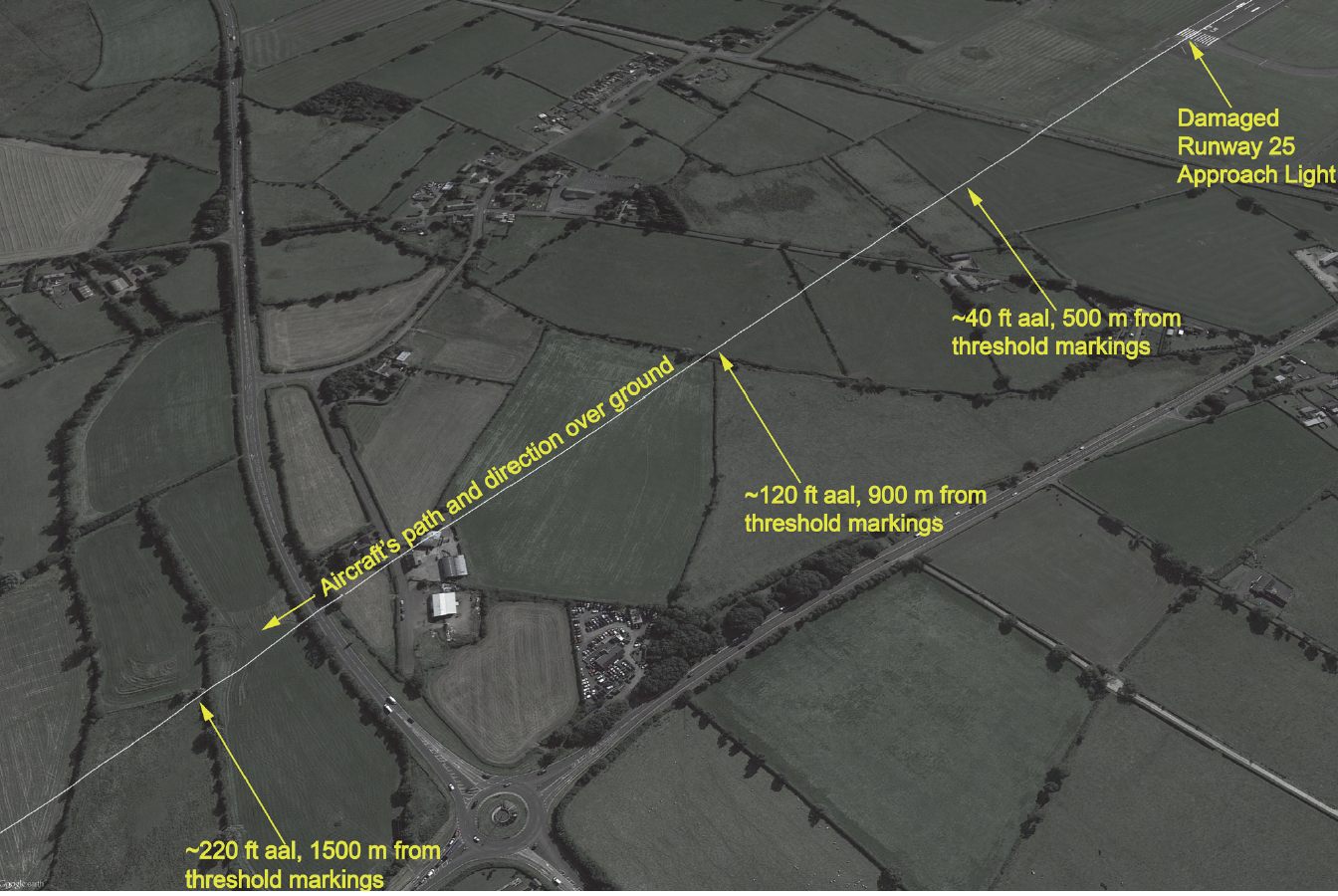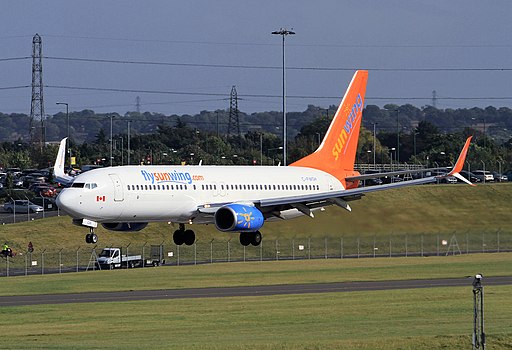
ASN Wikibase Occurrence # 199853
This information is added by users of ASN. Neither ASN nor the Flight Safety Foundation are responsible for the completeness or correctness of this information.
If you feel this information is incomplete or incorrect, you can submit corrected information.
| Date: | Friday 21 July 2017 |
| Time: | 15:39 UTC |
| Type: |  Boeing 737-86J (WL) |
| Owner/operator: | Sunwing Airlines, opf Thomson Airways |
| Registration: | C-FWGH |
| MSN: | 37752/3835 |
| Year of manufacture: | 2011 |
| Fatalities: | Fatalities: 0 / Occupants: 185 |
| Aircraft damage: | None |
| Category: | Serious incident |
| Location: | Belfast International Airport (BFS/EGAA) -
 United Kingdom United Kingdom
|
| Phase: | Take off |
| Nature: | Passenger - Scheduled |
| Departure airport: | Belfast International Airport (BFS/EGAA) |
| Kerkyra-I. Kapodistrias Airport (CFU/LGKR) | |
| Investigating agency: | AAIB |
| Confidence Rating: |
Thomson Airways flight BY1526, a Boeing 737-800, damaged a runway approach light following a long takeoff from Belfast International Airport.
The aircraft was operated by a Canadian airline, Sunwing Airlines, on behalf of Thomson Airways on a flight from Belfast International Airport to Corfu, Greece.
At some point during the cockpit preparation, a figure of -47°C was entered into the Flight Management Computer (FMC) as the outside air temperature (OAT). The FMC uses the OAT when calculating the value of N1 which will produce the engine’s rated thrust.
At a lower OAT, the engine will require a lower value of N1 to achieve this rated thrust. Therefore, entering an incorrect and abnormally low OAT, causes the FMC to calculate a value of N1
(and therefore thrust) significantly below that required to produce rated thrust in the actual conditions. Neither pilot noticed the error. Having completed the performance calculations, the crew reduced the takeoff thrust further by entering into the FMC a correctly-calculated assumed temperature thrust reduction of 47°C.
At 14:12 hrs the aircraft began to push back off the parking stand for its departure. During the pushback, the ground crew noticed that one of the nose landing gear tyres had a patch of worn rubber which they brought to the attention of the pilots. An engineer was called to look at the tyre and concluded that it needed changing. As a result, the aircraft returned to the parking stand and the engines were shut down. The engineers changed both the nose landing gear tyres, as is standard practice, and the aircraft was again ready to depart at 15:21 hrs. During this period the co-pilot updated the weather information from the ATIS and noted that the OAT had increased by 1°C. He recalculated the takeoff performance, which the commander checked before entering the new details in the FMC. He used 48°C to replace the previously-entered value for the assumed temperature thrust reduction but used an incorrect value of -52°C to replace the previously-entered (and incorrect) value for the OAT. The FMC used this information to calculate a thrust setting for takeoff of 81.5% N1. The aircraft pushed back from its parking stand at 15:21 hrs, and the flight crew started both engines before taxiing for departure from runway 07.
At 15:39 hrs, C-FWGH was cleared for takeoff on runway 07 from taxiway D, which gave a Takeoff Run Available (TORA) of 2,654 m. During the takeoff, at a speed of around 120 to 130 kt, the crew realised that the aircraft was not accelerating normally. They estimated, during post flight interviews, that they reached V1 with around 900 m of the runway remaining and rotated shortly afterwards. The aircraft, which was seen by multiple witnesses, took a significant time to lift off before climbing at a very low rate. After the aircraft lifted off from the runway, one of the aircraft tyres struck a runway light, which was 36 cm tall and 29 m beyond the end of the TORA. After takeoff, the crew checked the aircraft's FMC which showed that an N1 of 81.5% had been used for the takeoff. This figure was significantly below the required N1 setting of 92.7%.
It appeared that the FMC software version fitted to C-FWGH, U10.8A, predated revision U12.0, which features a crosscheck between the OAT entered by the crew and that sensed by the external temperature sensor.
The investigation found the following causal factors for this serious incident:
1. An incorrect OAT was entered into the FMC, which caused the FMC to calculate an N1 setting for takeoff which was significantly below that required for the aircraft weight and environmental conditions.
2. The incorrect OAT was not identified subsequently by the operating crew.
3. The abnormal acceleration during the takeoff run was not identified until the aircraft was rapidly approaching the end of the runway, and no action was taken to either reject the takeoff or increase engine thrust.
The investigation found the following contributory factors for this serious incident:
1. The aircraft’s FMC did not have the capability to alert the flight crew to the fact that they had entered the incorrect OAT into the FMC, although this capability existed in a later FMC software standard available at the time.
2. The Electronic Flight Bags (EFB) did not display N1 on their performance application (some applications do), which meant that the crew could not verify the FMC-calculated N1 against an independently-calculated value.
3. The crew were unlikely to detect the abnormally low acceleration because of normal limitations in human performance.
Accident investigation:
 |
|
Sources:
1. https://assets.publishing.service.gov.uk/media/59c2302140f0b60d848fd9ad/AAIB_S2-2017_C-FWGH.pdf
2. https://www.gov.uk/government/publications/aaib-current-field-investigations/air-accidents-investigation-branch-current-field-investigations
History of this aircraft
Other occurrences involving this aircraft
| 20 April 2023 | C-FWGH | Sunwing Airlines | 0 | over Fayetteville, NC |  |
non |
| Litium battery thermal event | ||||||
Images:

Groundspeed data for the takeoff in relation to V1 and Vr (AAIB / © 2017 Google, Image © 2017 DigitalGlobe)

Vertical profile for the initial climb-out (AAIB / © 2017 Google, Image © 2017 DigitalGlobe)
Media:



Revision history:
| Date/time | Contributor | Updates |
|---|---|---|
| 20-Sep-2017 19:51 | harro | Added |
| 20-Sep-2017 20:40 | Iceman 29 | Updated [Source] |
| 21-Sep-2017 07:34 | harro | Updated [Source, Narrative, Photo, ] |
| 21-Sep-2017 07:35 | harro | Updated [Photo, ] |
| 18-Oct-2018 21:54 | Dr.John Smith | Updated [Location, Destination airport, Source, Embed code, Narrative] |
| 21-Nov-2018 19:30 | harro | Updated [Cn, Source, Embed code, Narrative, Accident report, ] |
| 09-Oct-2022 18:32 | harro | Updated [Destination airport] |
Corrections or additions? ... Edit this accident description
The Aviation Safety Network is an exclusive service provided by:


 ©2024 Flight Safety Foundation
©2024 Flight Safety Foundation